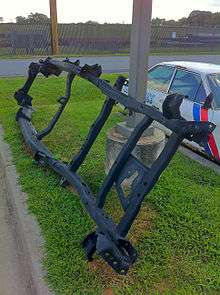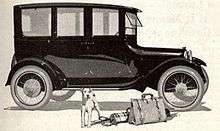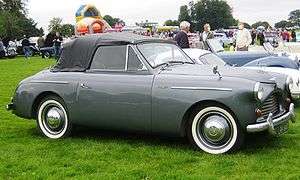Body-on-frame
Body-on-frame is an automobile construction method by which a separate body is mounted on a relatively rigid frame or chassis that carries the engine and drivetrain. It was the original method of building automobiles, but is now used mainly for pickup trucks and SUVs.
In the late 19th century the frames, like those of the carriages they replaced, might be made of wood (commonly ash), reinforced by steel flitch plates - but in the early 20th century steel ladder frames or chassis rapidly became standard. Mass production of all-metal bodies began with the Budd Company and the Dodge Brothers. Mass production of all-metal bodies became general in the 1920s but Europe, with exceptions, followed almost a decade later. Europe's custom-made or "coachbuilt" cars usually contained some wood framing or used aluminium alloy castings.
Unibody designs, where panels within the body supported the car on its suspension, were developed by European manufacturers in the late 1920s with Budd USA (which had a number of large factories in Europe) and its technical knowhow; but not in USA until the 1950s and generally later. Because of the high cost of designing and developing these structures and the high cost of specialised machinery to make the large pressings required by this style of construction it is not used by low-volume manufacturers, who might construct an equivalent by welding steel tube to form a suitable space frame.



Body by Edward G Budd Manufacturing Company of Philadelphia for John and Horace Dodge[1]
.jpg)

History
The Ford Model T carried the tradition of body-on-frame over from horse-drawn buggies, helping to facilitate high volume manufacturing on a moving assembly line.[2] In the USA the frequent changes in automotive design made it necessary to use a ladder frame rather than unibody construction to make it possible to change the design without having to change the chassis, allowing frequent changes and improvements to the car's bodywork and interior (where they were most noticeable to customers) while leaving the chassis and driveline unchanged, and thus keeping costs down and design times short. It was also easy to use the same chassis and driveline for several very different cars. Especially in the days before computer-aided design, this was a big advantage.[3]
Most small passenger vehicles switched to unibody construction by the end of the 1930s. The trend had started with cars like the Citroen Traction Avant (1934) and Opel Olympia (a General Motors design) introduced in 1935. Trucks, bus manufacturers and large low volume cars or those made in USA continued to use separate bodies on "conventional" frames. Body-on-frame remains the preferred construction method for heavy-duty commercial vehicles (especially those intended to carry or pull heavy loads, such as trucks and some sport utility vehicles (SUVs)) but as production volumes rise increasing numbers of SUVs and crossover SUVs are switching to unibody frames. Mass-market manufacturers Ford, General Motors and Chrysler are abandoning true body-on-frame SUVs, opting, when sales volume permits, for more efficient unibody construction.[4] Toyota currently manufactures the most body-on-frame SUVs with the 4Runner, Sequoia, Land Cruiser, Lexus GX and LX followed by Nissan with the Patrol, Armada, and Infiniti QX56/80.[5] The Ford Panther platform, which was discontinued in 2011, was the last series of traditional passenger cars to be built in this manner.
One variant used by Chevrolet for its Corvette incorporates the inner skeleton to the frame.
An intermediate to full monocoque construction was the 'semi-monocoque' used by the Volkswagen Beetle and Renault 4. These used a lightweight separate chassis made from pressed sheet steel panels forming a 'platform chassis', to give the benefits of a traditional chassis, but with lower weight and greater stiffness. Both of these chassis were used for several different models. The mid-1930s designed Volkswagen made use of the bodyshell for structural strength as well as the chassis — hence 'semi-monocoque'. Traditionally chassis had "compliance", they were designed to allow some twisting. As suspensions improved they could not perform correctly unless supporting a rigid structure like that intended to be provided by unibody or monocoque construction.
The Lincoln Town Car once dominated the American limousine market because it was the last American luxury car made on the body-on-frame system and it was easily lengthened for livery work. With the Town Car discontinued since 2011, the de facto replacement is the Lincoln Navigator SUV.
Advantages and disadvantages
Advantages
- Easier to design, build and modify. (partly due to today's computer-aided design (CAD) for coach-built vehicles in particular)
- Less noise while travelling, because the groans squeaks and rattles normally associated with bodywork movement due to stresses and strains are not heard so much, and road noise from tyres is more 'distant', all due to the bodywork being isolated from the chassis by rubber pads around the attachment bolts, or by suspending the body on the chassis.
- Easier to repair after accidents. This is crucial for first responders (police, fire, EMS) and anyone who needs their vehicle to earn a living. Damaged bolt-on wings, bumpers etc.: can be replaced easily, and in the case of a 'working vehicle' they can be returned to earning status almost immediately. A monocoque (one piece) vehicle shell would need specialist repairs, which could mean long delays before the vehicle is usable again.
- Can allow more torsional flexing before yielding (trucks, truck-base SUVs, off roading) [6]
- Vehicles mounted high on a separate chassis such as trucks and true off-road SUVs are less likely to suffer damage from rust caused by dampness, mud, stones, road grit, water, snow, and other more serious damage like the transmission or engine oil sump damage often caused by rocks.

Disadvantages
- The complete vehicle will often be heavier than a monocoque shell, resulting in diminished performance and higher fuel consumption.
- Body-on-frame vehicles with high ground clearance such as trucks and true off-road SUVs have high centers of gravity, compromising their on-road performance.
- Torsional flexing during cornering can compromise the handling and road grip.
- Many older body-on-frame vehicles have no inbuilt crumple zones, so their crashworthiness is below that of a monocoque shell with crumple zones.
Examples
The following is a list of production cars, SUVs, and light-duty pickup trucks available in the United States that currently have a body-on-frame construction. The list is divided by vehicle category.
SUV
- Cadillac Escalade (ESV)
- Chevrolet Suburban
- Chevrolet Tahoe
- Ford Expedition (EL)
- GMC Yukon (XL)
- Infiniti QX80
- Jeep Wrangler (Unlimited)
- Lexus GX
- Lexus LX
- Lincoln Navigator (L)
- Mercedes-Benz G-Class
- Nissan Armada
- Toyota 4Runner
- Toyota Land Cruiser
- Toyota Sequoia
Pickup Truck
See also
References
- ↑ page 106, George A Oliver, A History of Coachbuilding, Cassell, London, 1962
- ↑ Great Moments in Body-on-Frame Car Construction WSJ, May 2, 2014
- ↑ Sawyer, Christopher A. (2009-06-02). "Framing the question | Automotive Design & Production | Find Articles at BNET". Findarticles.com. Archived from the original on 2009-02-11. Retrieved 2009-12-08.
- ↑ "Car Reviews, New and Used Car Prices, Photos and Videos - MSN Autos". editorial.autos.msn.com. Retrieved 10 April 2018.
- ↑ "Toyota reaffirms commitment to body-on-frame SUVs". autoblog.com. Retrieved 10 April 2018.
- ↑ "Body-on-Frame vs. Unibody Construction - Web2Carz". web2carz.com. 15 August 2013. Retrieved 10 April 2018.
- ↑ "Austin A40 Sports". Austin Memories. Archived from the original on 2009-01-05.